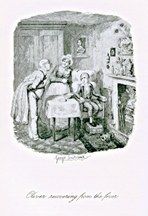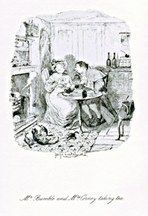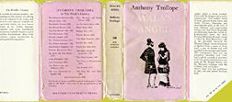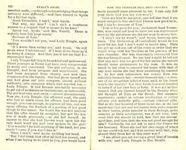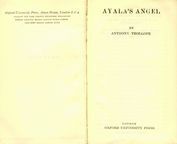Graphic or Verbal: A Dilemma
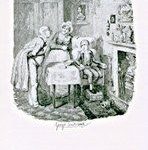
J. Hillis Miller looks at the "multimedia" Victorian novel, embodied in ink, paper, cardboard, and glue.
This essay is drawn in part from a book by Miller entitled Black Holes, forthcoming next year from Stanford University Press.
When I began the study of Victorian literature fifty years ago, it had almost been forgotten that most Victorian novels were illustrated; that is, twentieth-century reprints often omitted the original illustrations altogether. The illustrations were, however, an integral part of the reading experience for the first readers of Dickens, Trollope, or most other Victorian novelists. Dickens is the example most elaborately studied, partly because of his intrinsic importance, partly because the illustrations for his novels were by such distinguished graphic artists, most notably George Cruikshank and Hablot K. Browne (“Phiz”). ^1 Charles Dickens and George Cruikshank. The Fiction of Realism: Sketches by Boz, Oliver Twist, and Cruikshank’s Illustrations. Memorial Library, University of California, 1971. p 1-69. Of his childhood encounter with the Cruikshank plates for Oliver Twist, Henry James in his autobiography has this to say:
“It perhaps even seemed to me more Cruikshank’s than Dickens’s; it was a thing of such vividly terrible images, and all marked with that peculiarity of Cruikshank that the offered flowers or goodnesses, the scenes and figures intended to comfort and cheer, present themselves under his hand as but more subtly sinister, or more suggestively queer, than the frank badnesses and horrors.” ^2 Henry James. A Small Boy and Others. New York: Charles Scribner’s Sons, n.d., 1913. p 120.
James might have had in mind such a plate as the one that shows Oliver after he has been rescued by Mr. Brownlow, “Oliver recovering from the fever,” or the one that shows “Mr. Bumble and Mrs. Corney taking tea.”
To read Oliver Twist without the Cruikshank illustrations is to miss much of the meaning of the novel as it was originally published. Now it is easy to scan these illustrations, to make them available digitally, to project them as illustrations for a lecture or to insert them in an essay on the novel, like this one.
More and more literary works of this period are being made available in electronic form with the original illustrations included. A notable example is British Poetry 1780-1910: a Hypertext Archive of Scholarly Editions. This is being prepared at the University of Virginia under the direction of Jerome McGann. Within that archive the most ambitious subsection is the Dante Gabriel Rossetti archive. This will gather together not only all of Rossetti’s poetry but also all of his paintings and drawings. Since Rossetti was a salient Victorian example of a multimedia creator, since he was both a distinguished poet and a distinguished painter, it is impossible to study him adequately without setting the poetry and the painting side by side. An example would be the need to juxtapose the poem “The Blessed Damozel” and the painting of the same title. The Rossetti archive at the University of Virginia does this in a comprehensive way. It is a paradigmatic example of the way the new electronic media can aid scholarship, criticism, and historical understanding in Victorian studies. Anyone with a connection to the World Wide Web will have access soon to all of Rossetti’s poetry, painting, and drawings in an authoritative and manipulable form.

One major problem exists, however, in this digitizing of the literary and art historical past. Let me illustrate this problem with an example. Last summer on Deer Isle, Maine, where I spend my summers, I was re-reading a novel by Anthony Trollope, Ayala’s Angel (1881). I brought with me my old copy of the Oxford World Classics reprint of this novel. This reprint was originally published in 1929. It was reissued several times thereafter (my copy is dated 1960) as part of a more or less comprehensive edition of Trollope’s novels. These were included over fifty years ago in the World’s Classics series (in which Ayala’s Angel was number 342), long before personal computers were invented. A note at the end of the book tells me it was “set in Great Britain at the University Press, Oxford, and Printed by J. W. Arrowsmith Ltd, Bristol.” It cost ”10s 6p. net in U.K. only,” and I bought it in London in the late 1960s. I first read the novel in this edition. It is a quasi-sacred object for me, an object with which I have a long personal association. I have carried it from place to place as part of my library. My relation to this object is an example of the way so many readers of my generation and of many generations before mine have participated in a more or less benign fetishism of the book.
My Ayala’s Angel is a little book in small but readable type, six inches by a little less than four inches by one inch in size. It still has its pink paper dust-jacket. On the front of this is a black and white print of a bewhiskered Victorian gentleman in top hat, black coat, and white spats facing an elegant Victorian lady with black hat, scarf, and muff. Her eyes are modestly downcast. Her narrow dress reaches the ground. He faces her boldly, with his hand on his hip, elbow akimbo. The other hand leans on a walking stick. The cloth binding of the book is blue, Oxford blue, like all the books in the World’s Classic series. The seal of Oxford University is embossed in the cloth. All the prestige and authority of one of the world’s great universities are present in that blue binding and in the seal. To read the book almost makes me feel like a member of the university, as if I had fulfilled Jude Fawley’s dream in Hardy’s Jude the Obscure and had moved from outside to inside of Oxford for the small sum of 10s 6p. The little book feels comfortable in my hands. I could carry it in my pocket and have done so. It not only feels familiar, it also smells familiar; it has that faint smell of paper, printer’s ink, glue, cardboard, and cloth that those who belong to the book culture know so well. I know how to read it (word after word in linear sequence from page one to the end), and how to find my way around in it.
Ayala’s Angel, however, was also available to me on Deer Isle in another way: as an electronic book, part of the Oxford Text Archive collection of such books. I had access to that by way of my portable computer and the modem that connected me by courtesy to the Internet server at Colby College. What is the difference between reading Ayala’s Angel in book form and reading it in electronic text form? I have stressed the physical embodiment of Ayala’s Angel in the World Classics edition. Not only is the text of the novel caught in the materiality of the book, it is also tied by way of its paper, cardboard, ink, and glue to the historical and economic conditions of its production and distribution. It was part of a moment in English publishing history when one of the great academic/commercial English publishers made “classic” books in Western literature available in inexpensive form. This was preceded by earlier moments, first by the initial publication of the book in 1881, then by subsequent cheap editions. Many of Trollope’s novels were reprinted in yellow-bound paperback editions sold in railway stations in the late nineteenth century. The twentieth-century World’s Classics version was thus a later stage in English publishing history. It depended on the existence of a large literate middle-class reading public in Britain at the time. It also depended to some degree on the fact that television was not yet available.
The Oxford University Press in the twentieth century was, moreover, an international operation. Its books were marketed all over the world, but especially by way of cities once in British colonies or parts of the British Empire. The globalization of the English language did not occur by accident or because of some intrinsic superiority of that language. The list of cities where the Oxford University Press in 1960 (on the page facing the title page) asserts itself as located reads like a litany of sites associated with British colonialism and imperialism: “Glasgow, New York, Toronto, Melbourne, Wellington, Bombay, Calcutta, Madras, Karachi, Kuala Lumpur, Cape Town, Ibadan, Nairobi, Accra.” The sun never sets on the Oxford University Press. In all these ways, and in others, the little book that I hold in my hand is embedded in history, embodies that history in material form, and gives me access to that history.
The electronic text version of Ayala’s Angel is cut off from all these signs of its historical context. Or rather it is given a strange new historical placement in today’s “cyberspace.” A date of original publication is indicated and that is about all. The novel exists not as embodied in material form, or at least not as material in the same fixed way as a printed book. It exists as a large number of “bits” of information, zeroes or ones inscribed as magnetic differences on a hard disk or on magnetic tape or as minute scratches on an optical disk or as electrical pulses on the wires and wireless transmissions of the Internet. Ayala’s Angel as an electronic book takes on a novel meaning when it is placed in this new context, when it floats in cyberspace. It is detached from its local historical context and becomes a “text” in the context of an enormous and incoherent abundance of works of all kinds - verbal, pictorial, and auditory - on the Internet. As such it might now be the object of a globalized “cultural studies” by scholars who are themselves more and more transformed, in part by their use of the computer and by their inhabitation of cyberspace, in their relation to the culture of the book. This is the case even though it is still a primary goal of literary history and literary criticism in the modern languages to understand and interpret that culture of the book.
The electronic form of Ayala’s Angel in the Oxford Text Archive has one tremendous advantage over the printed form. It can easily be searched and manipulated. The user’s sense of the fragility of the text’s inscribed embodiment is reinforced by the fact that once I have got the whole file in my computer I can change it in all kinds of ways that would of course be impossible with a printed book. I can change the typeface into any one of over two dozen I have on my computer. Hundreds of other typefaces would be easily available. Also I can extract citations from anywhere in the novel and insert them anywhere else, for example in an essay on the novel. I could also easily deface the text in any way I might want, for example by scrambling the chapters, substituting a new word for every example of a given word, removing all examples of a given word or words, and so on. I could change every example of Ayala to Susan and turn the book into Susan’s Angel. I do not know why I would want to do that, but I could. My sense of the text is changed by my awareness of this vulnerability. This is a vulnerability quite different from a printed book’s liability to have pages torn out of it or be burned.
Most important, however, is my ability, if I have the right software, to apply various search techniques to the electronic Ayala’s Angel. I can almost instantly call up on screen every example of a given word or short string of words. Using a “Boolean search engine,” I can find all examples where any two words or strings are nearby, all places, for example, where eyes and lips are paired. What I would do with the results of such searches would be up to me, but it is clear that they facilitate certain kinds of critical analysis. When I find a passage that is especially interesting to me, I can call up in a few seconds all the other passages that contain the key words of that passage.
Such search capabilities do not yet quite turn Ayala’s Angel into a hypertext, though it would be easy to do so. A hypertext, as its name suggests, is a hyperbolic text, a text to a higher power, squared or cubed. A hypertext invites the reader to break down the usual linear way of reading from the first word through to the end, word by word.
A hypertext version of Ayala’s Angel would have links connecting one part of the novel to other parts associated by some principle of relation, so that the reader would have many different ways to read the novel, for example by reading all the chapters in which Ayala encounters Jonathan Stubbs, leaving out all the rest, or by following separately all the chapters involving Tom Tringle. A hypertext Ayala’s Angel might also have links connecting this or that passage in the novel to passages in all the rest of Trollope’s many novels and prose works that are related in some way. For example, hypertext links in the fox hunting chapters could connect the reader to all the other fox hunting passages in other novels and prose works by Trollope. Other links could take the reader outside Trollope altogether to contemporary texts about fox hunting, to pictures of fox hunts, and to sounds of hounds, hunting horns, and the cries of the hunters. The fact that the reader has to choose or not choose to click on a given link is what justifies the word “interactive” for this kind of reading.
The problem, however, is easy to see. It is the main point of this small essay to point out this problem. You cannot have it both ways in digitizing multimedia artifacts from the past like Victorian novels. If you want to preserve the graphic look of the pages, the typeface used, the dust jacket, the illustrations, and so on, you must digitize the work in facsimile form, that is, treat all of the work, including the verbal part, as if it were a picture. It has been necessary for me to do that in order to show not only the Cruikshank illustrations for Oliver Twist but also the dust jacket and other features of Ayala’s Angel. My example is meant to show that much can be learned about history, even in the case of such secondary or tertiary editions, from close attention to what might be called the materiality of the book, its binding, dust jacket, title page, and so on. Another way to put this would be to say that purely verbal artifacts from the past have an important multimedia aspect that can only be preserved by facsimile digitizing. On the other hand, such a digitized form of Ayala’s Angel or any other artifact cannot be searched or manipulated in the way I have described as so useful in historical research and criticism. The digitized dust jacket of Ayala’s Angel preserves one of these values at the expense of the other. The Oxford Text Archive preserves the other at the expense of the first. I do not see how these two values can be combined in a single format. The only solution would be to have all these historical artifacts digitized in two different ways, as facsimiles that would preserve all the graphic aspects so important to historical study and as searchable electronic texts of the sort that make up the Oxford Text Archive and that are so useful for another kind of historical study. This, however, might be prohibitively expensive, particularly in large-scale projects. An example of the latter is the enormous project underway to preserve copies of all those brittle books printed on acid paper in the period from about 1850 until quite recently. There are over a hundred million such items in the United States alone, about ten million different titles. Only about a third of these will be saved, at most. It seems unlikely, given the enormous costs involved, that this one third will be saved in more than one form. Microfilm would save the graphic aspect, but is not searchable and manipulable. Digitized versions, which will probably be used more frequently, are searchable but lose the original graphic aspect. This is the dilemma to which my title refers. If the searchable form alone is saved and the book or manuscript crumbles away, the graphic aspect will be lost forever, like an extinct species.
Works Cited
Charles Dickens and George Cruikshank. The Fiction of Realism: Sketches by Boz, Oliver Twist, and Cruikshank’s Illustrations. Memorial Library, University of California, 1971. p 1-69.
Henry James. A Small Boy and Others. New York: Charles Scribner’s Sons, n.d., 1913. p 120.
Cite this essay
Miller, J. Hillis. "Graphic or Verbal: A Dilemma" Electronic Book Review, 1 January 1998, https://electronicbookreview.com/publications/graphic-or-verbal-a-dilemma/
